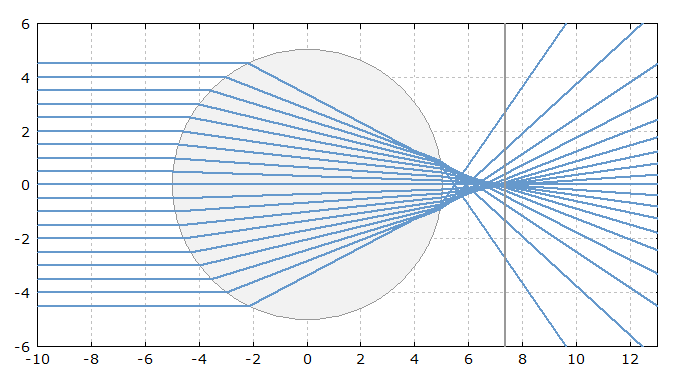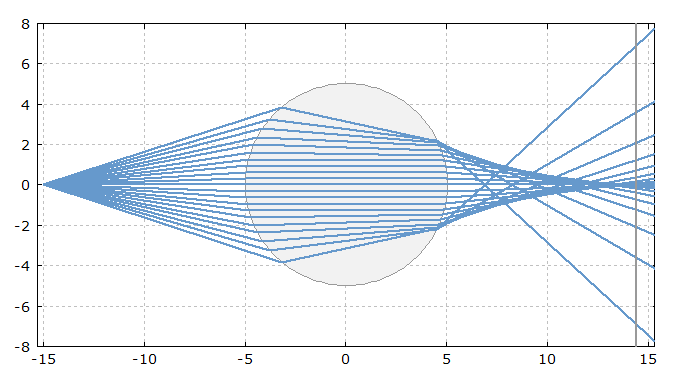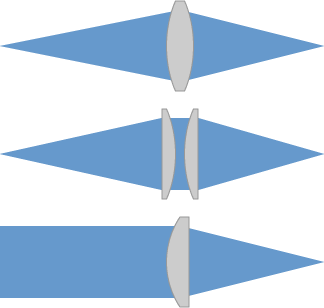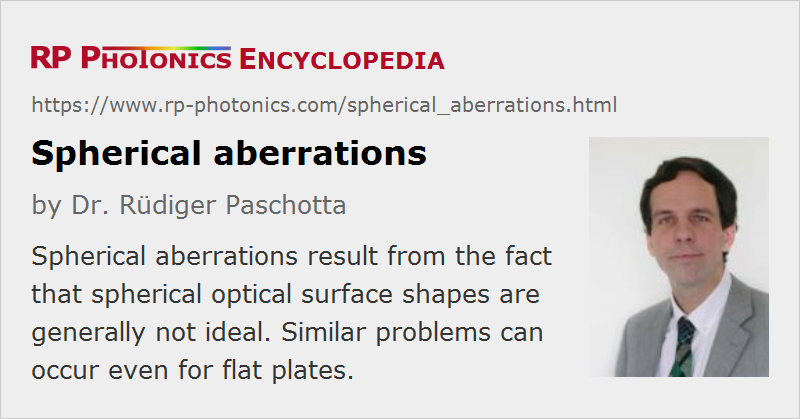Spherical Aberrations
Definition: optical aberrations resulting from spherical optical surfaces
More general term: optical aberrations
German: sphärische Aberrationen
Categories: general optics, vision, displays and imaging
How to cite the article; suggest additional literature
Author: Dr. Rüdiger Paschotta
Most optical lenses have spherical surfaces, because those can be most easily fabricated with high optical quality. That surface shape, however, is not ideal for imaging; the outer parts of the lens are then too strongly curved. This is most obvious when considering a ball lens. Figure 1 demonstrates this for a ball lens with 10 mm diameter and a refractive index of 1.515 (N-BK7 glass at 633 nm), which is used to focus parallel incoming light. The outer incoming rays are crossing the optical axis substantially sooner than the paraxial ones.


When using lenses with spherical surfaces for imaging applications, the explained effect leads to so-called spherical aberrations which can seriously degrade the image quality. Similarly, the use of spherical lenses for focusing or collimating laser beams leads to beam distortions.
In many cases, the aberration effects are far less extreme than those shown above for the ball lens, since the involved curvatures are not that strong.
Spherical Aberrations from Plane Plates
The problem of spherical aberrations can be generalized to all aberrations associated with a non-ideal radial dependence of phase changes. That can occur even for plane surfaces, e.g. of plane-parallel plates, when divergent or convergent light travels through such a plate. This is essentially because the law of refraction contains the sine rather than the tangent function, which would be required to avoid spherical aberrations.
An example case in shown in Figure 3.

Quantification of Spherical Aberrations
The strength of spherical aberrations of an optical system or an optical component such as a lens is often quantified by plotting the deviation of the longitudinal position of the image focal point as a function of the transverse offset of incident rays. Often, one exchanges the coordinate axes, so that the resulting plot corresponds more closely to a horizontal optical axis. The mentioned position error may scale with the square of the transverse beam coordinate, but in cases where the spherical aberrations are partly compensated (see below), that compensation may work for a particular horizontal offset but not so well for other offsets.
Reducing Spherical Aberrations
Spherical aberrations can be reduced in different ways:
- The simplest method is to restrict the area of the incoming light with an optical aperture. That way, one can prevent that the outer regions, where spherical aberrations are most extreme, contribute to the image. However, that implies a reduced light throughput.
- One can use aspheric lenses, which have modified surface shapes such that spherical aberrations are avoided.
- One can use a combination of spherical lenses designed such that spherical aberrations are well compensated. This method is frequently used in photographic objectives, for example.
To some extent, one can also reduce spherical aberrations by choosing an appropriate type of lens, depending on the required configuration (see Figure 3):
- For imaging a small spot to a spot of equal size, the symmetric biconvex lens is well suited. However, it is even better to use two plano-convex lenses in combination, with the flat surfaces on the outer sides.
- For an asymmetric application, such as focusing a collimating beam or collimating a strongly divergent beam, a plano-convex lens can be more appropriate. The best solution would actually be an asymmetric lens with optimized curvature radii on both sides, but a plano-convex lens is often close enough. It must be oriented such that the curved surface is on the side of the collimated beam. Both lens surfaces then contribute to the focusing action.

Generally, lenses should be used such that both surfaces contribute similarly to the focusing action.
The development of improved optical fabrication methods for aspheric optics has led to their increased use, allowing manufacturers to make high-performance objectives with fewer lenses – which can also result in improved light throughput. Note, however, that other kinds of optical aberrations can then still occur.
Questions and Comments from Users
Here you can submit questions and comments. As far as they get accepted by the author, they will appear above this paragraph together with the author’s answer. The author will decide on acceptance based on certain criteria. Essentially, the issue must be of sufficiently broad interest.
Please do not enter personal data here; we would otherwise delete it soon. (See also our privacy declaration.) If you wish to receive personal feedback or consultancy from the author, please contact him e.g. via e-mail.
By submitting the information, you give your consent to the potential publication of your inputs on our website according to our rules. (If you later retract your consent, we will delete those inputs.) As your inputs are first reviewed by the author, they may be published with some delay.
See also: optical aberrations, lenses
and other articles in the categories general optics, vision, displays and imaging
 |



If you like this page, please share the link with your friends and colleagues, e.g. via social media:
These sharing buttons are implemented in a privacy-friendly way!